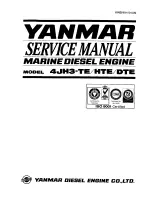
ADJUSTMENT
Running the engine with the boat out of the water,
without load and without cooling water, will seri-
ously damage it, due to overheating. Therefore,
always lower the boat into the water immediately
after the engine has been started, so as to pre-
vent over-speeding and to allow cooling water to
be forced up to the cylinder-head. Having carried
out the initial running-in (''breaking-in'') proce-
dure as described before, complete the running-
in as follows:
WARNING :
Fig.-
1
1.
2.
3.
4.
Open the throttle slightly
from the idling position
and start the engine,
following the procedure
described previously.
Lower the boat into the water, gradually open the
throttle and run the boat straight ahead for 20 to 30
metres at full throttle. Now return the model and
close the needle-valve 20 to 30
°
. Repeat the run,
taking note of the improvement in speed.
Continue with further runs, gradually closing the
needle-valve (20 to 30
°
at a time) until no further
increase in speed is obtained.
If the needle-valve is closed beyond the optimum
setting, the model will slow down, accompanied by
visibly diminished exhaust smoke. In this case,
immediately throttle down and return the model to
shore. Re-open the needle-valve approximately
one-half turn and repeat the runs until the
optimum needle setting is found.
5.
6.
Aim to have the model achieving its highest
performance after the engine has consumed about
one liter of fuel. Having found the optimum needle-
valve setting, make a note of the number of turns
necessary to quart this from the closed position.
With the engine run-in and the optimum needle-
valve setting determined, the mixture control valve
should be checked as follows:
16
Содержание max-21RG-M
Страница 29: ...MEMO 28 ...














































